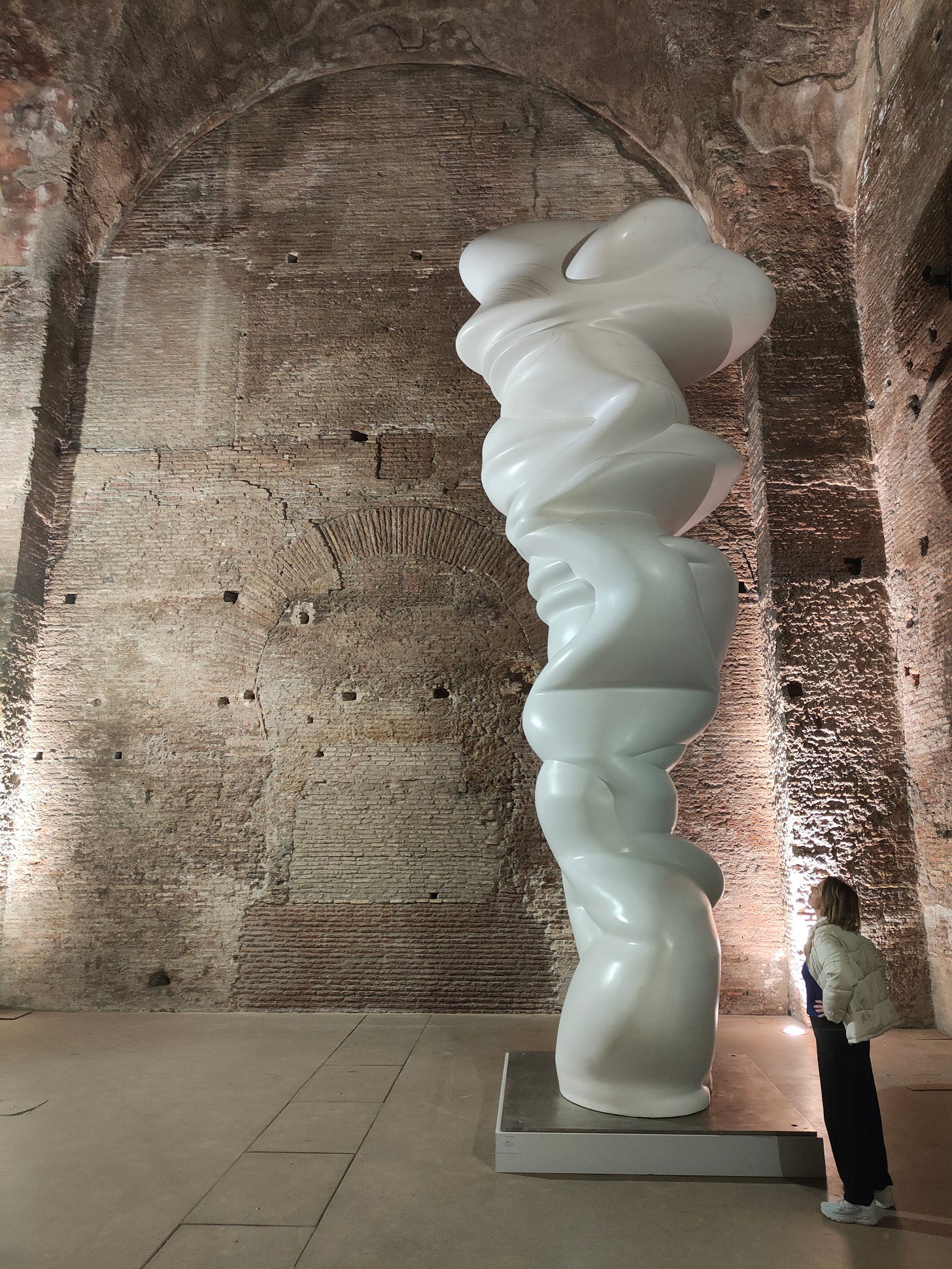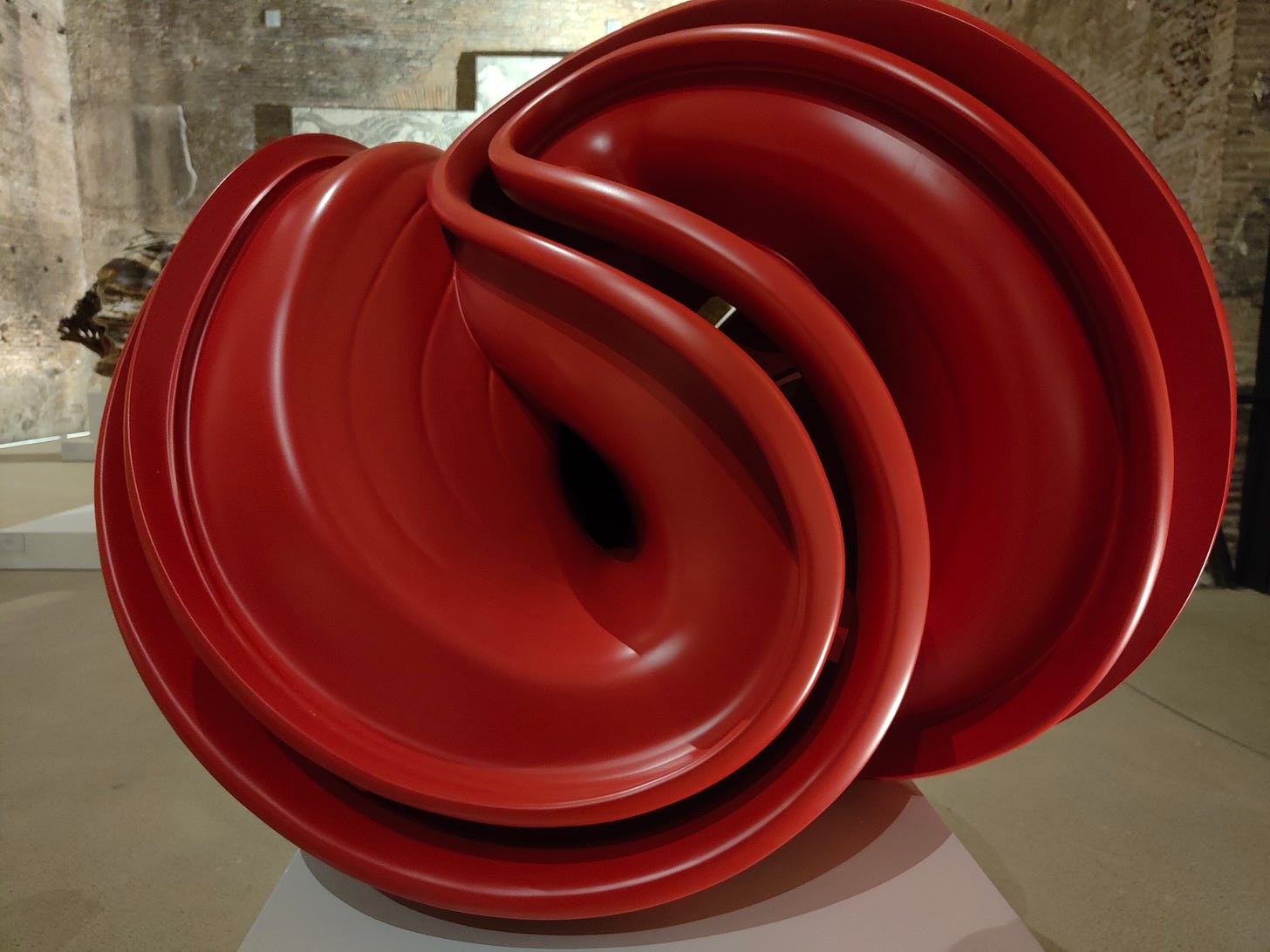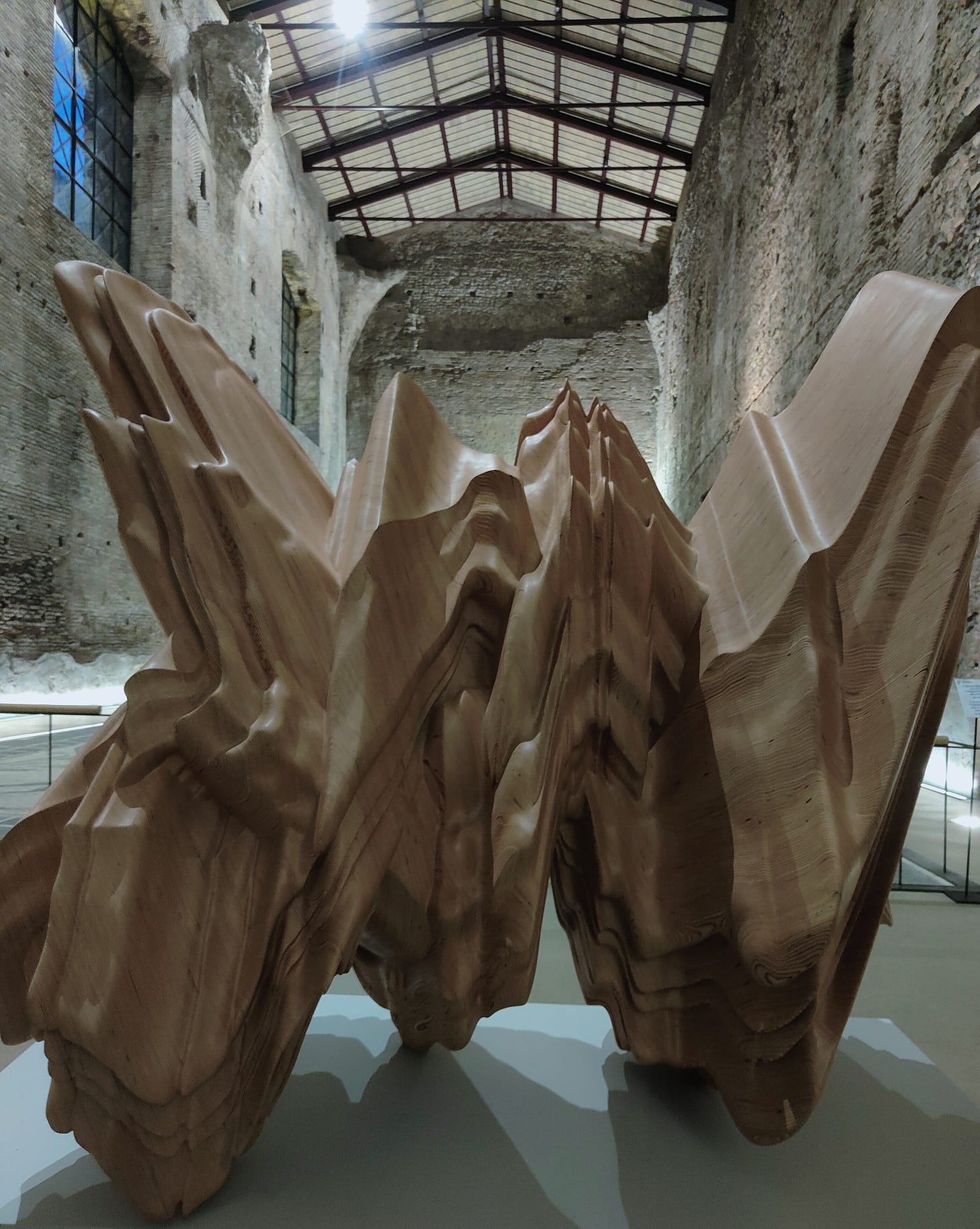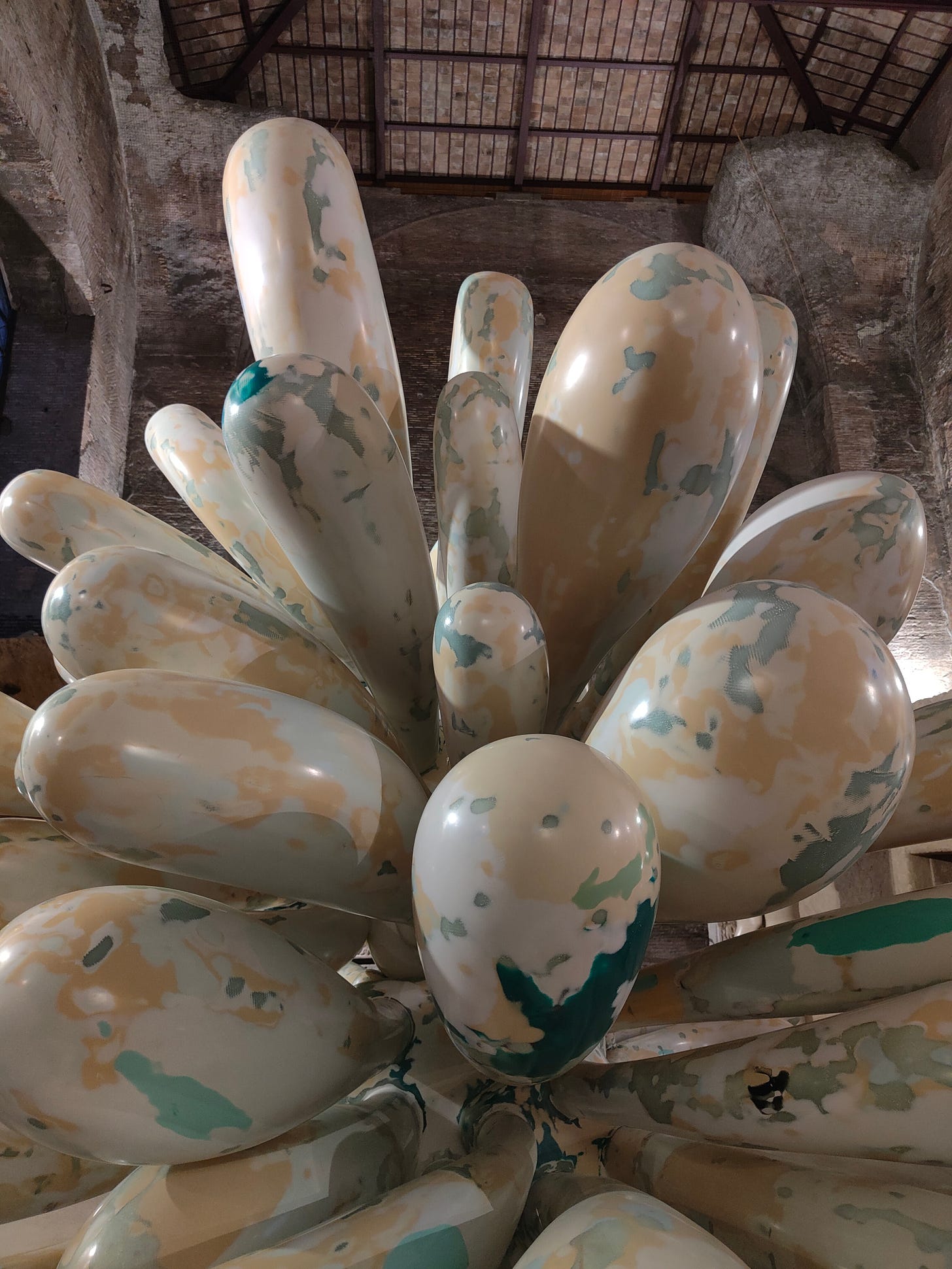Art Snap-shot: Tony Cragg takes a deep dive into the Diocletian Baths.
Tony Cragg's sculpture exhibition "Infinite forms that are beautiful," takes its title from a quote by Darwin. Now up at the National Roman Museum, the show is well worth a visit. It ends May 4th.
"Art Snap-Shots” is my latest Sub-Sustack newsletter series, focusing primarily on local art happenings in Italy and beyond. It joins the "Detour-ism" series dedicated to city life and urban culture. Thanks for subscribing!
The electronic billboard above the Metro station in Pigneto caught my attention the other morning. The screen endlessly cycles through travel advertisements, new film releases and community service announcements, but I did a double take when I saw the promotion for the exhibition on the sculptor Tony Cragg at the Diocletian Baths. I like Cragg’s work, and the exhibition’s location inside these ancient and voluminous spaces would surely be worth a visit.
The Diocletian Baths sit right in front of Rome’s main train station Termini, but oddly enough, they don’t really draw much attention. Much of the sprawling Diocletian complex is still standing and in use and as such it largely blends into Rome’s surrounding urban fabric. In fact, fragments of the baths, which date from around 300 AD, have been made into a planetarium, a majestic church (first renovated by Michelangelo and later by Luigi Vanvitelli), and a historic museum, the “Museo Nazionale Romano. (National Roman Museum)”
The museum first opened in 1889 and houses a vast collection of ancient Roman artifacts. In time, the museum has grown to include 3 other venues around the capital, including the Palazzo Massimo across the street, and the Palazzo Altemps located behind Piazza Navona. You could say the museum’s collection attracts all kinds of people, like the camp artist Francesco Vezzoli who plucked a number of pieces out of the museum’s storage for his classicist exhibition at the Palazzo delle Esposizioni last year.

The exhibition on Cragg at the National Roman Museum is curated by Sergio Risaliti, Artistic Director of the Museo Novecento in Florence, and Stephan Verger, a French scholar and archaeologist who took over the directorship of the Roman museum in 2020. Sergio Risaliti is well known in Tuscany: I was first exposed to his curatorial prowess when I was teaching summers in Siena, when he was then director of the Palazzo delle Papesse. I should have remembered as I stepped into these vast rooms inside the Diocletian Baths that I had already visited a previous exhibition on Cragg curated by Risaliti in Florence back in 2023.
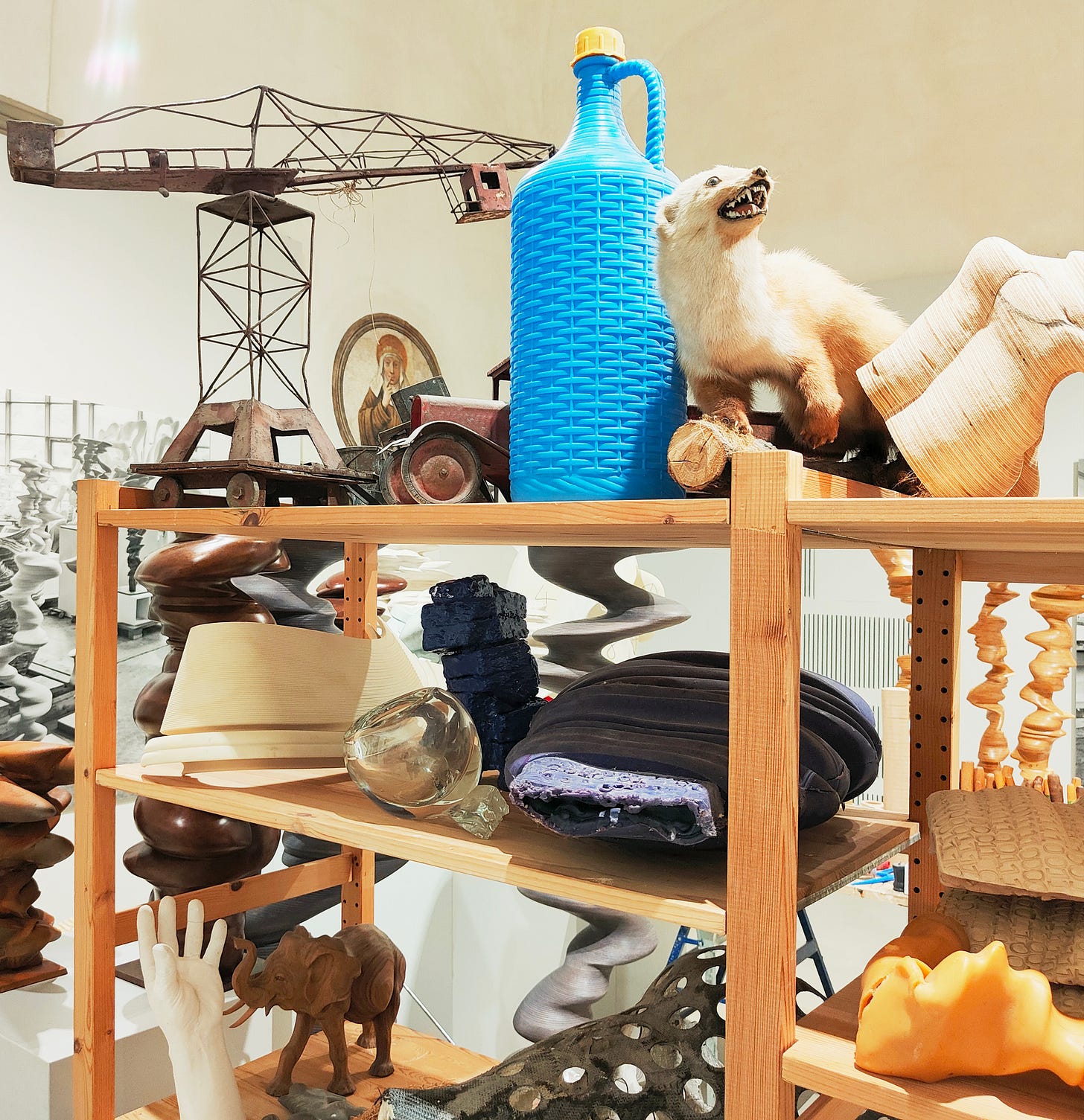
Clearly these are two different types of shows. Risaliti’s approach to Cragg’s artwork in that exhibition, called Transfer, was much more comprehensive, and along with some of the more familiar sculptures there were also rooms dedicated to some of Cragg’s lesser known earlier works, including plenty of drawings. Elsewhere in the museum you could encounter cabinets and shelves filled with everyday objects, including stuffed animals, models of sculptures, toys, all intended to give visitors the impression that you were inside his studio. This collection of artifacts was most likely there to offer visitors a few clues as to Cragg’s creative sources. Certain strange shapes, body parts, sea shells, plastic containers could, if you squinted long enough, reveal their forms in some of the artist’s work scattered around the Florentine galleries.
While the Florence exhibition was impressive, the museum's rooms were mostly straightforward volumes, nothing that would be comparable to the kind of monumental spaces looming over you at the Diocletian Baths. The Director of the National Roman Museum and the show’s co-curator, Stephan Verger, is one of the people who deserves to be credited for bringing contemporary art into these immense ancient spaces in the first place. While there were a number of earlier shows that went up in these repurposed halls— they were mainly used for storage space—Tony Cragg succeeds in making the most out of these spectacular settings.
The manner in which some of Tony Cragg’s larger sculptures occupy these grand spaces reminds me of the artworks of Henry Moore, who made bold and large abstract forms based on his collections of bones, rocks, stones and other odd shapes. But Moore’s work is part of another generation, Cragg is even more organic, but also at times more plastic. Literally.
I heard Tony Cragg has been teaching at the Dusseldorf Art Academy so I called up my artist friends Matthias Köster and his wife Kirsten Lampert, who both attended the Art Academy and continue to be involved with the place. I did my best to describe to them what Cragg had put together for his exhibition here in Rome, and asked if either one of them would share their thoughts on the artist and his recent work. Right away my friends named Jeff Koons and Anish Kapoor, two of Tony Cragg’s contemporaries, who they believe Cragg admires. From them I got the impression that Cragg’s artwork falls somewhere between the two of them.
Cragg’s teaching career at the Dusseldorf Art Academy had humble beginnings, the British-German artist, who I should add, has renounced his British citizenship after Brexit, was very popular among the Art Academy students who signed up for his first year foundation course. Apparently, according to Kirsten, he has a knack for creatively inspiring his students, with obviously lasting effects on their education.
Matthias, more specifically, suggested Cragg was drawn to Koons’ populist cartoon and toyish figures. Then again, Anish Kapoor is a frequent guest and exhibits his works at the Rudolf Steiner inspired home and outdoor sculpture park run by Cragg in Wuppertal. Interestingly, Kirsten and Matthias told me they both went to see Tony Cragg’s most recent exhibition at the Dusseldorf Kunst Palast last Spring, and thought it was his most daring show to date: visitors were encouraged to touch all the artworks on display. Called “Please Touch!” the exhibition I am told was a big hit with the public. Touching Cragg’s work is an irresistible impulse I admit, and fortunately for me, the guards at the National Roman Museum didn’t pay much attention to policing visitors while I was there.

Once I finished at the Diocletian Baths, I sprinted over to meet some friends at the Sicilian caffe and pastry-shop Dagnino. Its tucked inside the Galleria Esedra, a modern interior shopping arcade on the opposite corner from Piazza Repubblica. Dagnino may not be that popular these days, but its an excellent getaway from the surrounding tourist spots and features besides its enticing pastry selection, a dining area whose walls are decorated with colorful abstracted figures. While I was there having something to drink, I began imagining what I would want to do if I could have the chance, inside those enormous halls where Cragg is now. I think I could come up with something.





